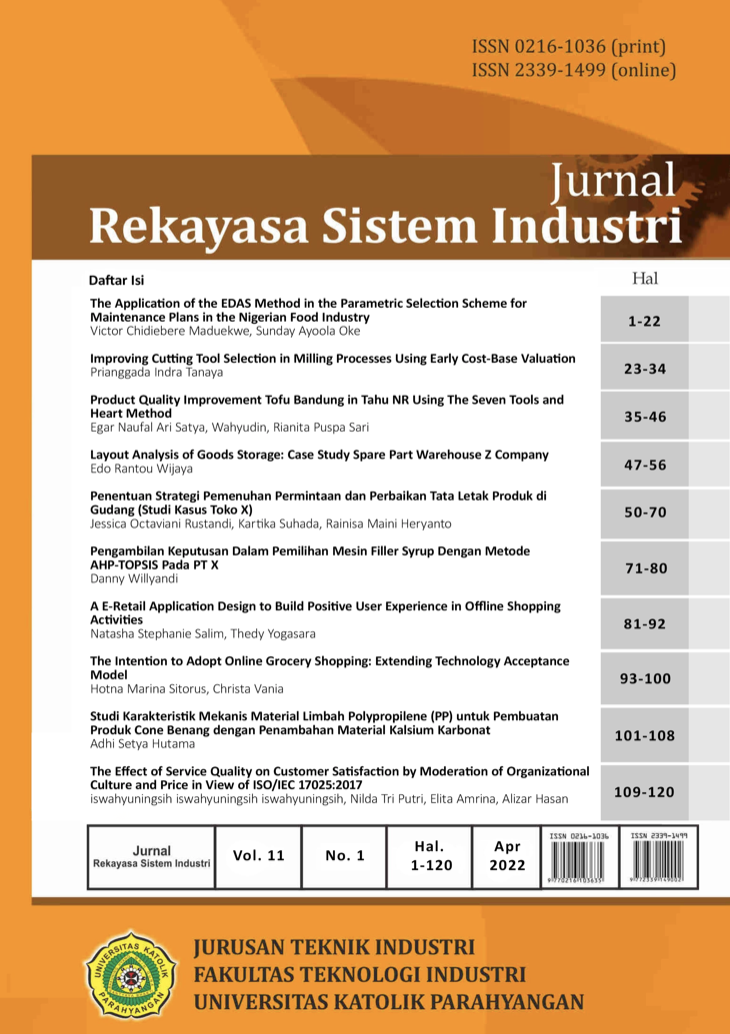The Intention to Adopt Online Grocery Shopping: Extending Technology Acceptance Model
DOI:
https://doi.org/10.26593/jrsi.v11i1.5204.93-100Keywords:
technology adoption, compatibility, social influence, risk, TAMAbstract
The purpose of this paper is to study factors affecting customer intention to adopt Online Grocery Shopping (OGS) technology. OGS is a service provided by supermarket which enables customers to purchase groceries online. While OGS services offer various benefits, the adoption in Indonesia is still low. The proposed model is developed by extending Technology Acceptance Model with compatibility, visibility, social influence and perceived risk. The model is evaluated using partial least square structural equation modeling (PLS-SEM) based on 108 valid data collected from supermarket customers. The findings show that the customers’ intention to adopt OGS is significantly affected by perceived usefulness and perceived ease of use. Based on total effect analysis, it was found that the intention to adopt OGS is determined by compatibility, perceived usefulness, perceived ease of use, social influence and perceived risk. Furthermore, the study proposes several recommendations for supermarket managers to improve the adoption of OGS.
References
Chaouali, W., Yahia, I. B., & Souiden, N. (2016). The interplay of counter-conformity motivation, social influence, and trust in customers' intention to adopt Internet banking services: The case of an emerging country. Journal of Retailing and Consumer Services, 28, 209-218.
Chien, A. W., Kurnia, S. & von Westarp, F. (2003). The Acceptance of Online Grocery Shopping. Proceedings of 16th Bled Electronic Commerce Conference, Bled, Slovenia, 219-233.
Cho, E., & Son, J. (2019). The effect of social connectedness on consumer adoption of social commerce in apparel shopping. Fashion and Textiles, 6(1). https://doi.org/10.1186/s40691-019-0171-7
Davis, F.D. (1989). Perceived Usefulness, Perceived Ease of Use, and User Acceptance of Information Technology. MIS Quarterly, 13(3), 319-340.
Driediger, F. & Bhatiasevi, V. (2019). Online grocery shopping in Thailand: Consumer acceptance and usage behavior, Journal of Retailing and Consumer Services, 48, 224-237.
Giovanis, A.N., Binioris, S., & Polychronopoulos, G. (2012). An extension of TAM model with IDT and security/privacy risk in the adoption of internet banking services in Greece. EuroMed Journal of Business, 7(1), 24-53.
Ha, S., & Stoel, L. (2009). Consumer e-shopping acceptance: Antecedents in a technology acceptance model. Journal of Business Research, 62(5), 565-571.
Hair, J.F., Hult, G.T.M., Ringle, C.M., & Sarstedt, M. (2014). A Primer on Partial Least Squares Structural Equation Modeling (PLS-SEM). Singapore: Sage Publications.
Li, Y. H., & Huang, J. W. (2009). Applying theory of perceived risk and technology acceptance model in the online shopping channel. World Academy of Science, Engineering and Technology, 53(1), 919-925.
Miller, J., & Khera, O. (2010). Digital library adoption and the technology acceptance model: A cross‐country analysis. The Electronic Journal of Information Systems in Developing Countries, 40(1), 1-19.
Moore, G. C., & Benbasat, I. (1991). Development of an instrument to measure the perceptions of adopting an information technology innovation. Information Systems Research, 2(3), 192-222.
Rogers, E. M. (2003). Diffusion of Innovations, New York: The Free Press.
Saadé, R., & Bahli, B. (2005). The impact of cognitive absorption on perceived usefulness and perceived ease of use in on-line learning: an extension of the technology acceptance model. Information & Management, 42(2), 317-327.
Sitorus, H.M., Govindaraju, R., Wiratmadja, I.I., & Sudirman, I. (2016). Technology adoption: an interaction perspective. IOP Conference Series: Materials Science and Engineering, 114, 1-7.
Sitorus, H.M., Govindaraju, R., Wiratmadja, I.I., & Sudirman, I. (2019). Examining the Role of Usability, Compatibility and Social Influence in Mobile Banking Adoption in Indonesia. International Journal of Technology, 10(2), 351-362.
Venkatesh, V., & Davis, F. D. (2000). A theoretical extension of the technology acceptance model: Four longitudinal field studies. Management Science, 46(2), 186-204.
Venkatesh, V., Morris, M. G., Davis, G. B., & Davis, F. D. (2003). User acceptance of information technology: Toward a unified view. MIS Quarterly, 27(3), 425-478.
Verhoef, P. C., & Langerak, F. (2001). Possible determinants of consumers’ adoption of electronic grocery shopping in the Netherlands. Journal of Retailing and Consumer Services, 8(5), 275-285.
Wu, J. H., & Wang, S. C. (2005). What drives mobile Commerce?: An empirical evaluation of the revised technology acceptance model. Information & management, 42(5), 719-729.

